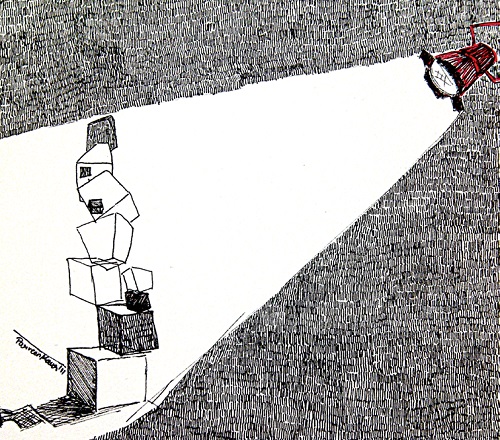
Editors’ note: This article is featured in NPQ’s winter 2014 edition, “Births and Deaths in the Nonprofit Sector.”
What governs the survivability of new organizations? What is at stake, and what choices do organizations face along the road to maturity? Those seeking to start a nonprofit group with the objective of doing good in the world have a number of options, and this article reviews theories on the life cycle–related threats and opportunities that await the young nonprofit.
Birthing Options
Those seeking to start up a nonprofit must decide how they wish the organization to function. One option is to operate as an informal group of people, bound to each other only by the agreement of group members. These groups are often limited in size or tenure; they do not have the organizational rights of a more formal group, nor do they bear responsibility to an organizational structure beyond what is necessary to keep the effort organically knit together and moving forward—and this by voluntary agreement. There is something essential about this moment. It is the point at which the only reason a group does things is because those things need to be done to further the cause. If the group has an urge or reason to be more formal, however, it may choose to become a legally recognized nonprofit entity, and in this case it can be set up as an unincorporated association, a charitable trust, or a nonprofit corporation.
Unincorporated associations, the simplest legal form, are allowed to have a bank account in their name and to have tax-deductible contributions made to them. They have few other beneficial features. The charitable trust form is common in many other countries but has relatively limited use in the United States, where charitable trusts tend to be used by organizations whose purpose is to make grants. The most common type of legally recognized nonprofit in the United States is a nonprofit corporation with IRS tax exemption. These organizations must report to their respective states and the IRS, and otherwise adhere to requirements of their formality. They must keep their contracted promises as a group and adhere to proper decisionmaking procedures. As Fredrik Andersson writes, young organizations can find this difficult. Some will stay nascent for a while, only gradually arriving at independence and formality.1
The nascent stage is formative, and somewhat predictive of the future.2 Is the organization premature, or has it placed itself under the umbrella of another organization only to find itself smothered? When it launched, was it really ready to do so? Does it have a strong sense of purpose and will to survive? That reason for being and the collective life force of the group are important factors—more important, in fact, than many others.
In the end, it is wiser to be born into organizationhood at the right time: when a group is sure that its niche is clear; when it knows that it has the will, heft, and capacity to live; and when it has some idea about how to negotiate its environment. The establishment of a new nonprofit corporation is relatively easy and generally no barrier unless someone at the IRS decides that a particular field needs special scrutiny. State-level incorporation and IRS tax exemption depend primarily on the establishment of a charitable mission and the assurance of a minimal organizational structure to accomplish it (such as a board of directors and bylaws). While accomplishment of these first organizational milestones is, no doubt, an occasion for the founders to celebrate, this is merely the start of a difficult process.
The Vulnerability of Infant Organizations
Once an organization is established, there are all manner of threats to negotiate. Indeed, private organizations are very vulnerable in their early years. It is well known that business start-ups have high failure rates. Using data on firms started in 2005, the U.S. Census Bureau found that a mere 43 percent of these firms still existed five years later.3 While the percentage can vary somewhat depending on the industry or the year of analysis, the conclusion is that youth is a hazardous time for new businesses.
So, what causes businesses to fail? A lack of capital, a misunderstanding of the market, a faulty model for how to attract and maintain that market—there are any number of factors that likely sound familiar to many nonprofits. It is true that evidence suggests that the rate of failure among nonprofits may not be as dire as it is for profit-making organizations. Teresa Harrison and Christopher Laincz examined data from the National Center on Charitable Statistics (NCCS) on all 501(c)(3)s that filed a tax return between 1989 and 2003.4 They found that 12 percent of these nonprofits exited from the data within five years and 17 percent exited within ten years. But the great IRS purge of 2011 and 2012 attests to the fact that the statistics were, prior to that, tempered by a dearth of declarations—in other words, that quiet deaths had occurred. Many of the organizations eventually found to no longer exist in the course of this purge were, due to their small size, not required to report and thus were assumed to be current. Once the IRS’s new reporting requirement kicked in, these phantoms were unable to comply and were, finally, declared dead.
How to Survive
New nonprofits face a number of significant challenges if they are to survive and, more importantly, have significant impact. Much has been written about organizational functioning in start-up years, and we can use insights gleaned from this literature to help us understand these challenges. Below we examine the implications contained in a number of relevant concepts and theories.
The Liability of Newness
Organizational theorists have long noted that organizations face developmental risks associated with where they are in their life cycles. Arthur Stinchcombe, who was the first to argue that an organization’s risk of dying is highest at the point of its founding and decreases with age, associated high mortality in new and younger organizations with three factors:5
- New organizations that are acting in new areas require their members to perform new roles. Learning these roles takes time and leads to inefficiency.
- New organizational members who do not know each other need time to develop trust.
- New organizations need to build stable relationships with clients and other environmental stakeholders.
Some of the problems that may plague organizations during this period are interpersonal conflicts, difficulties related to how decisions are made (and by whom), and a lack of systems (program protocols, financial data management, human resources, board policies and frameworks, etc.) to support meeting the expectations of stakeholders (including funders, staff and volunteers, beneficiaries of the activity, and so on).
The Liability of Smallness
A related line of research has examined how organizational size influences failure. The liability of smallness posits that small organizations have a propensity to fail. This smallness-related vulnerability results from problems in raising capital, recruiting and training a workforce, and handling regulatory compliance.6 As organizations grow, they increasingly emphasize predictability, formalization, and control, demonstrating greater reliability and accountability. But this transition is not always easily made. Traditionally, the period during which an organization transitions from informality to greater formality is often fraught with blame and shame, as well as, sometimes, the loss of key movers and shakers, as smallness burns out leaders.
The Liability of Age
Sign up for our free newsletters
Subscribe to NPQ's newsletters to have our top stories delivered directly to your inbox.
By signing up, you agree to our privacy policy and terms of use, and to receive messages from NPQ and our partners.
In 1991, Mark Fichman and Daniel Levinthal suggested that, during an organization’s formative years, a convex (Ç-shaped) relationship exists between age and failure.7 New organizations begin with a stock of assets (such as goodwill, positive beliefs, commitment, resources) that buffer them during an initial honeymoon period, even if they struggle in the early stages. The larger the initial stock, the longer the organization is buffered. As these assets are depleted, however, organizations that are unable to develop sustainable resource supplies are increasingly likely to fail.
{loadmodule mod_banners,Ads for Advertisers 5}
The new nonprofit faces a plethora of issues that are likely to include lack of visibility to the environment, confusion about structure, overconfident leadership, and shallow systems. The nonprofit will have to answer critical questions, such as: “Why do we exist?” “How will we make a difference?” “How will we establish our presence?” “Who does what?” “How will we know we are successful?” In addition to asking the right questions and establishing hypotheses for how the organization will operate, the nonprofit will need to ensure that adequate capacity and support are available to start proving the hypotheses—to some extent—within a few years. Without this, the nonprofit is unlikely to survive.
The discussion above brings up a paramount issue for new nonprofits: while it is important to consider both internal functioning and the external environment, it may prove particularly problematic for young nonprofits to assess and respond to the environment, because the complexities are new. Nonprofits are influenced by a number of environmental factors, including other organizations, the availability of resources, and the normative expectations of stakeholders. Organizational theories have been developed to consider these aspects of the environment, and we will examine three of these in terms of their implications for new nonprofits.
Population Ecology Theory
Population ecology theory uses ecological models borrowed from biology to analyze populations of organizations. Populations are aggregates of organizations that have important similarities, such as what they do and where they get resources. For example, nonprofit day-care organizations would comprise a population.
In Michael Hannan and John Freeman’s model, population dynamics occur through the three stages of variation, selection, and retention.8Variation is the stage that generally occurs earliest in an organization’s life, and it refers to the generation of organizations that diversify the field. While this could take place through major change in existing organizations, it can also happen via the development of new organizations—for example, an organization might be developed to provide specialized support to LGBT high school students, where more general support services exist but have not been able to address the specific needs of that population in a way that is culturally attuned.
What characterizes this different organization is its environmental niche. Niches are domains of unique resources and needs. For example, the day-care niche is composed of those wanting day care and the resources available for day-care providers. Consequently, a new nonprofit must understand its niche and its characteristics, such as the number of providers, degree of competition, demand for services, and availability of resources. It is also important to assess the niche’s “carrying capacity,” or number of organizations it could support. A relatively full niche is likely to be a more difficult environment than a relatively sparse one. Considering these factors, a new nonprofit may be able to choose a niche that is favorable for it.
A new population of nonprofits will initially have high death rates, since the forms are untested, resources are less predictable, and the environment is not familiar with the organizations. As more experience is gained, a relatively stable middle period follows, where births are roughly equal to deaths. Finally, a late period ensues when death rates rise again due to competition from newer populations. A new nonprofit, therefore, will be influenced by where its population is in its life cycle. All other things being equal, a new nonprofit is likely to have the hardest time in either a very new or a very old population, as population death rates will be highest at these times.
Also affecting the ability of an organization to survive is the degree of instability and change in the environment. What is important is how large or drastic environmental changes are and how quickly they occur—and these factors will affect specialist and generalist organizations differently. Generalists have broad product lines, such as a nonprofit hospital, while specialists, such as a neighborhood clinic, have narrow ones. Research has found that in environments where change is drastic but slow, generalists have the advantage, since they have more resources to make big changes. In environments where change is fast but not very drastic, specialists have the advantage, as they can make small changes more quickly. If changes are both drastic and fast, all organizations will have difficulties. Thus, a new nonprofit should consider the turbulence of its environment when deciding to become a generalist or a specialist.
Resource Dependence Theory
Resource dependence theory deals with how organizations attempt to avoid becoming dependent upon others. It describes the acquisition and use of power. An organization (“A”) will become dependent upon another (“B”) to the degree that “B” provides important resources and there are few alternative suppliers. This will be exacerbated if “B” is not likewise dependent on “A.” In this situation, “A” is vulnerable and its autonomy could be threatened, as “B” could impose additional demands. Organizations will, therefore, seek to minimize their dependencies by ensuring that they have potential alternative suppliers and customers whenever possible. New nonprofits will be especially susceptible to such dependencies, given their small size and lack of alternatives. The provision of a service not readily available elsewhere, however, would give them increased bargaining power. Another strategy would be to establish some control over critical others with, for example, long-term contracts, interlocking boards, or joint ventures. Finally, collaboration with other small nonprofits in similar circumstances would be a way to share risks and rewards. Such a coalition could have some countervailing power in dealing with a common dependency. For example, an association composed of the nonprofit day-care providers in a city could present a united front in negotiations with the city over resources.
Institutional Theory
Institutional theory considers a different dimension of a nonprofit’s environment. Besides market and economic controls, environments can impose institutional controls on organizations and regulate the processes by which work is accomplished. These controls are socially defined rules, regulations, and beliefs, and organizations are rewarded for conforming to them. This is especially pertinent when outputs are hard to objectively evaluate or when they are not sold in markets. Nonprofit organizations are particularly subject to these controls—after all, state and IRS regulations formally specify what the nonprofit form is, what nonprofits can do, and some aspects of their functioning. In addition, they may provide services whose outcomes may be difficult to evaluate objectively or which are provided to the general public or are free of charge. In these situations, stakeholders will seek to impose their norms and beliefs on nonprofits as a condition for their support. These may take the form of laws, procedural rules, or professional standards. For example, day-care centers are licensed, academic programs are accredited, and some types of services require professionals with proper credentials.
Nonprofits have some alternatives in dealing with their institutional environments. They could, for instance, comply with institutional expectations, especially if these are imposed by powerful actors in the environment. The situation is more difficult, however, if stakeholder demands vary or even conflict with one other. In such cases, the nonprofit must skillfully navigate through the configuration of demands. A nonprofit could also decouple its operations from environmental scrutiny. It could display conformity to the environment while protecting its operations from environmental influence. It could do this by providing information or other visible displays to the environment—essentially, showing the environment what it wants to see. Finally, the nonprofit could seek to influence its institutional environment by trying to change the viewpoints of influential stakeholders. Collaborating with other, similar nonprofits may be particularly useful in this instance. New nonprofits that are willing to make themselves dependent on particular resource providers may have little choice but to conform, and in doing so they may risk their niche. Banding with others in attempts to change the institutional environment may be their best alternative.
• • •
In sum, the infancy of a nonprofit is a time of exploration and testing of internal and external limits against what an organization wishes to achieve, and generally entails a number of missteps. These are par for the course—although as any parent of a young child can attest, some falls can be painful.
Notes
- Fredrik O. Andersson, “The Nascent Nonprofit Organization—What Happens Before a Nonprofit Is ‘Born’?,” in this edition, Nonprofit Quarterly, Winter 2014.
- Ibid.
- Scott Shane, “Start Up Failure Rates: The Definitive Numbers,” Small Business Trends, December 12, 2012, accessed October 10, 2014, smallbiztrends.com/2012/12/start-up-failure-rates-the-definitive-numbers.html.
- Teresa D. Harrison and Christopher A. Laincz, “Entry and Exit in the Nonprofit Sector,” B.E. Journal of Economic Analysis & Policy 8, no.1 (July 2008).
- Arthur L. Stinchcombe, “Social Structure and Organizations,” in Handbook of Organizations, James G. March, ed. (Chicago: Rand McNally & Co., 1965), 142–93.
- Howard E. Aldrich and Ellen Auster, “Even Dwarfs Started Small: Liabilities of Age and Size and Their Strategic Implications,” Research in Organizational Behavior 8 (1986): 165–98, ssrn.com/abstract=1497769.
- Mark Fichman and Daniel A. Levinthal, “Honeymoons and the Liability of Adolescence: A New Perspective on Duration Dependence in Social and Organizational Relationships,” Academy of Management Review 16, no. 2 (April 1991): 442–68.
- Michael T. Hannan and John Freeman, “The population ecology of organizations,” American Journal of Sociology 82, no. 5 (March 1977): 929–64.













